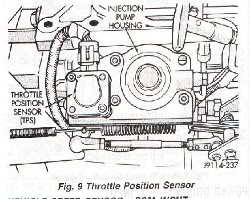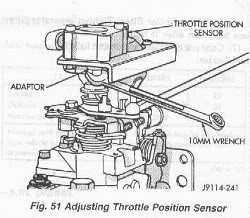Checking And Adjusting The Throttle Position Sensor ( TPS )
#1
Checking and adjusting the Throttle Position Sensor ( TPS ) is a common procedure necessary in order to maintain and tune the performance characteristics of your 12V Cummins. Removal of the TPS happens when you want to access the inside of the AFC housing to adjust the diaphragm or star-wheel. You will need to take a reference measurement, and reset it when complete. The 3-4 upshift and 4-3 downshift are effected by the TPS adjustment. The TPS can drift over time. It can also get dirty and worn. If you notice your OD shift points becoming erratic or have shifted over time, a dirty or worn TPS may be the cause.
Locating the TPS
The TPS is located at the top and front of the VE injection pump. The TPS has a 3 wire connector on the top, facing the engine. See Figure 1.

Figure 1
Under the TPS body, is a shaft that protrudes downward. The shaft has a hex head end that fits into a 'female' hex socket which is part of the cap screw that holds the throttle spring, spring cups etc. Always make sure to take reading on the voltage before removal or any adjustments.
Checking your TPS Voltage
Equipment Needed:
- DC Voltmeter
- Safety pin or paper clip with the end slightly sharpened
- 10mm combo wrench.
1. Slip the safety pin or paper clip into the 'socket' part were the center wire comes out of until it makes connection with the metal jacket inside.
2. Connect the "+" probe of your DVM the safety pin or paper clip.
3. Connect the "-" probe of your voltmeter to the "-" terminal on the battery
4. Turn on the Ign. key (do not start truck)
5. Check the "at rest voltage".
6. It should range between .6 VDC and 1.20 VDC. (make a note of the reading for reference.)
7. Next, slowly cycle the throttle smoothly to WOT then back to "at rest" and watch the meter. The meter should increase smoothly up and down with no jumps or spasms/twitching.
If it does, the TPS is still working OK, if not you've got a dirty one or its failing.
8. The total increase (above "at rest voltage") should range between 2.25 and 2.75 VDC.
Adjusting the TPS
1. Right near the top of the shaft were it first comes out of the TPS body, are two "flats"
were you put your open end wrench to adjust. See figure 2.
2. Turn the wrench counterclockwise to increase the voltage
3. Turn the wrench clockwise to decrease the voltage
4. Always make very slight adjustments.

Figure 2
Cleaning the TPS
1. Check the TPS voltage and make a note of the reading for reference
2. Remove the top TPS body itself by removing the two screws holding it down.
3. Carefully lift it up and note that underneath there is a plastic slot and key type indexing.
4. Once the TPS body is off you can turn it over and spray electrical contact cleaner into it, working it back and forth.
5. The use some gentle compressed air to dry out the spray cleaner if needed (it evaporates pretty quickly).
6. Reinstall it and try the reset procedure again and watch your dcv meter for smooth movement.
Removal Notes
The shaft is lightly spring loaded. When the hex headed bolt end is pulled upwards on removal the head/shaft may 'snap rotate' an 1/8 turn or so, so watch it as it comes out since it needs to go back in the same position.
Adjusting 3-4 Shift Points
Make +/- .2 VDC changes and road test the vehicle between each change.
Increasing the voltage will cause the 3-4 shift to happen Later.
Decreasing the voltage will cause the shift to happen Sooner.
When you do your test drive try to use the same throttle pressure/RPM for each, that way you'll know what effect you had with the adjustment. The preferred method is a "medium" throttle ( 1600 RPM ) and a WOT test each time.
I found that there was a point were the shift happened later, but also tended to cause the downshift (4-3) to be a bit touchy too, so you need to adjust in small increments and drive each time.
Last thing to check... make sure that your TV cable returns properly. The lever on the trans. case should move all the way forward with the truck off/idle. I had to add a "universal" throttle spring to be sure that happened, otherwise the line pressure(s)at idle are already increased above what they are supposed to be at idle and you may have harsh engagement when shifting from "P" or "N" into "D" or "R".
Bob. aka: BushWakr
Article From PDR Diesel Inc. The turbo diesel performance specialists! - 1st Gen TPS
Locating the TPS
The TPS is located at the top and front of the VE injection pump. The TPS has a 3 wire connector on the top, facing the engine. See Figure 1.

Figure 1
Under the TPS body, is a shaft that protrudes downward. The shaft has a hex head end that fits into a 'female' hex socket which is part of the cap screw that holds the throttle spring, spring cups etc. Always make sure to take reading on the voltage before removal or any adjustments.
Checking your TPS Voltage
Equipment Needed:
- DC Voltmeter
- Safety pin or paper clip with the end slightly sharpened
- 10mm combo wrench.
1. Slip the safety pin or paper clip into the 'socket' part were the center wire comes out of until it makes connection with the metal jacket inside.
2. Connect the "+" probe of your DVM the safety pin or paper clip.
3. Connect the "-" probe of your voltmeter to the "-" terminal on the battery
4. Turn on the Ign. key (do not start truck)
5. Check the "at rest voltage".
6. It should range between .6 VDC and 1.20 VDC. (make a note of the reading for reference.)
7. Next, slowly cycle the throttle smoothly to WOT then back to "at rest" and watch the meter. The meter should increase smoothly up and down with no jumps or spasms/twitching.
If it does, the TPS is still working OK, if not you've got a dirty one or its failing.
8. The total increase (above "at rest voltage") should range between 2.25 and 2.75 VDC.
Adjusting the TPS
1. Right near the top of the shaft were it first comes out of the TPS body, are two "flats"
were you put your open end wrench to adjust. See figure 2.
2. Turn the wrench counterclockwise to increase the voltage
3. Turn the wrench clockwise to decrease the voltage
4. Always make very slight adjustments.

Figure 2
Cleaning the TPS
1. Check the TPS voltage and make a note of the reading for reference
2. Remove the top TPS body itself by removing the two screws holding it down.
3. Carefully lift it up and note that underneath there is a plastic slot and key type indexing.
4. Once the TPS body is off you can turn it over and spray electrical contact cleaner into it, working it back and forth.
5. The use some gentle compressed air to dry out the spray cleaner if needed (it evaporates pretty quickly).
6. Reinstall it and try the reset procedure again and watch your dcv meter for smooth movement.
Removal Notes
The shaft is lightly spring loaded. When the hex headed bolt end is pulled upwards on removal the head/shaft may 'snap rotate' an 1/8 turn or so, so watch it as it comes out since it needs to go back in the same position.
Adjusting 3-4 Shift Points
Make +/- .2 VDC changes and road test the vehicle between each change.
Increasing the voltage will cause the 3-4 shift to happen Later.
Decreasing the voltage will cause the shift to happen Sooner.
When you do your test drive try to use the same throttle pressure/RPM for each, that way you'll know what effect you had with the adjustment. The preferred method is a "medium" throttle ( 1600 RPM ) and a WOT test each time.
I found that there was a point were the shift happened later, but also tended to cause the downshift (4-3) to be a bit touchy too, so you need to adjust in small increments and drive each time.
Last thing to check... make sure that your TV cable returns properly. The lever on the trans. case should move all the way forward with the truck off/idle. I had to add a "universal" throttle spring to be sure that happened, otherwise the line pressure(s)at idle are already increased above what they are supposed to be at idle and you may have harsh engagement when shifting from "P" or "N" into "D" or "R".
Bob. aka: BushWakr
Article From PDR Diesel Inc. The turbo diesel performance specialists! - 1st Gen TPS
The following 7 users liked this post by RSWORDS:
billylvnv58 (08-31-2012),
dbquarters02 (12-21-2009),
dodge_kim (10-21-2012),
Legato (12-13-2013),
packratc (03-14-2015),
and 2 others liked this post.










